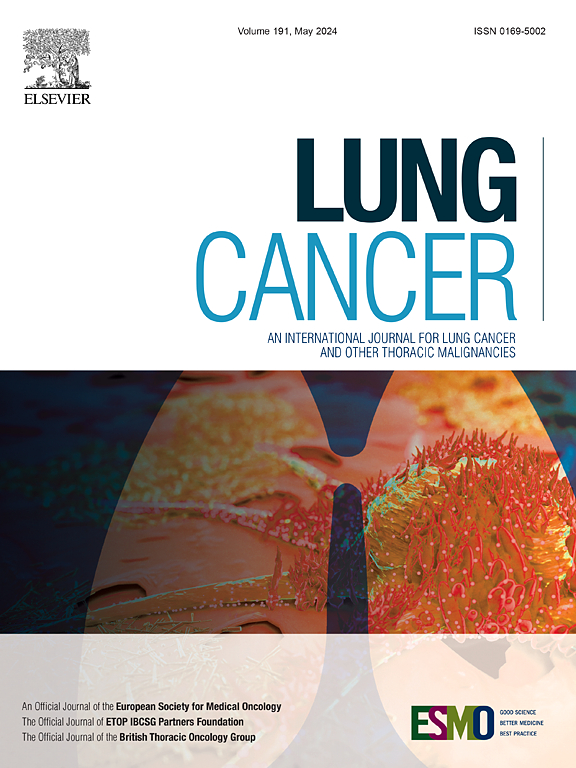可切除的III期非小细胞肺癌的定义:来自EORTC肺癌组的系统综述
IF 4.4
2区 医学
Q1 ONCOLOGY
引用次数: 0
摘要
III期非小细胞肺癌(NSCLC)是一种异质性疾病,需要多种治疗方法。对于可切除的III期非小细胞肺癌,结合手术的治疗可能是有益的,然而,缺乏可切除疾病的定义。欧洲癌症治疗和研究组织(EORTC)肺癌小组倡议旨在提供可切除的III期非小细胞肺癌的统一定义。作为这一倡议的一部分,我们进行了系统回顾,以确定可切除性的定义;作出决定所涉及的医学专业和协助作出决定所需的检查。方法纳入在2005- 2022年间以英语、荷兰语或法语发表的提供III期NSCLC可切除性数据或定义的研究。结果在70篇符合条件的文章中,46篇提供了决定可切除性的肿瘤特征。反对切除的因素包括:N3或大体积N2疾病和局部侵袭性肿瘤。有利于切除的因素包括n2 -单站受累和cT3N1。n2多站和cT4N0-1无侵犯是否定义为可切除尚不清楚。一个多学科委员会包括一名胸外科医生、一名内科(肺)肿瘤学家和一名放射肿瘤学家参与了95%研究的决定。70%的研究认为PET-CT是标准的,89%的研究认为MRI/CT是标准的。在80%的研究中,病理纵隔淋巴结确诊是强制性的。结论:本系统的文献综述强调了与可切除性相关的肿瘤特征,负责决定的专业以及III期NSCLC最合适的分期检查。本文章由计算机程序翻译,如有差异,请以英文原文为准。
Definition of resectable stage III non-small cell lung cancer: A systematic review from EORTC lung cancer group
Background
Stage III non-small cell lung cancer (NSCLC) is a heterogenous disease requiring a multimodality treatment approach. For resectable stage III NSCLC, treatments incorporating surgery might be beneficial, however, a definition on resectable disease is lacking. The European Organization for the Treatment and Research of Cancer (EORTC) Lung Cancer Group initiative aims to provide a uniform definition of resectable stage III NSCLC. As part of this initiative, we conducted a systematic review to identify definitions on resectability; the medical specialties involved for making the decision and the required work-up aiding the decision.
Methodology
Studies were included if they provided data or definitions on resectability in stage III NSCLC and were published in English, Dutch, or French between 2005- 2022.
Results
Out of 70 eligible articles, 46 provided tumour characteristics determining resectability. Factors against resection included: N3 or bulky N2 disease and locally invasive tumours. Factors favouring resection included N2-single station involvement and cT3N1. It remained unclear whether N2-multiple station and cT4N0-1 without invasion were defined as resectable. A multidisciplinary board including a thoracic surgeon, a medical (pneumo)oncologist and a radiation oncologist were involved in the decision in 95% of studies. PET-CT was considered standard in 70% and brain MRI/CT in 89% of the studies. A pathological mediastinal nodal confirmation was mandatory in 80% of the studies.
Conclusions
This systematic literature review highlights tumour characteristics related to resectability, the specialties responsible for the decision and the most appropriate staging work-up in stage III NSCLC.
求助全文
通过发布文献求助,成功后即可免费获取论文全文。
去求助
来源期刊

Lung Cancer
医学-呼吸系统
CiteScore
9.40
自引率
3.80%
发文量
407
审稿时长
25 days
期刊介绍:
Lung Cancer is an international publication covering the clinical, translational and basic science of malignancies of the lung and chest region.Original research articles, early reports, review articles, editorials and correspondence covering the prevention, epidemiology and etiology, basic biology, pathology, clinical assessment, surgery, chemotherapy, radiotherapy, combined treatment modalities, other treatment modalities and outcomes of lung cancer are welcome.
 求助内容:
求助内容: 应助结果提醒方式:
应助结果提醒方式:


